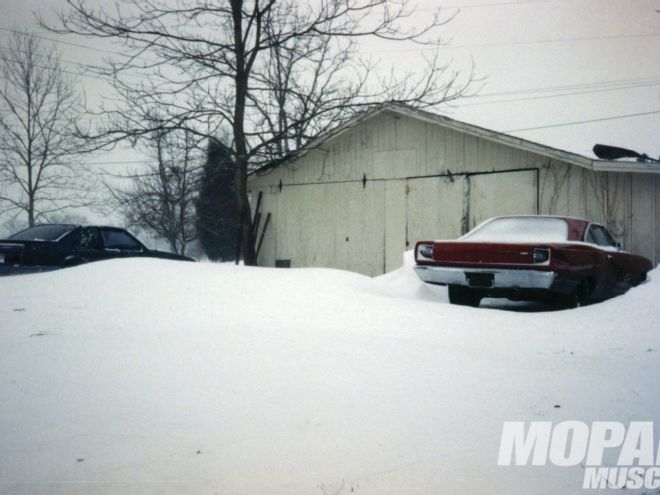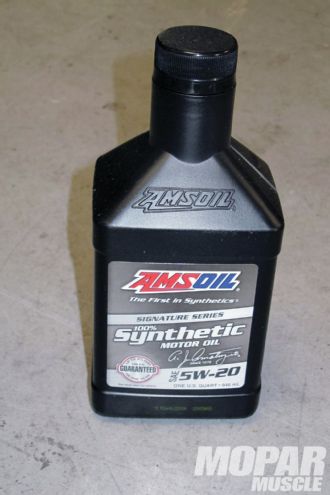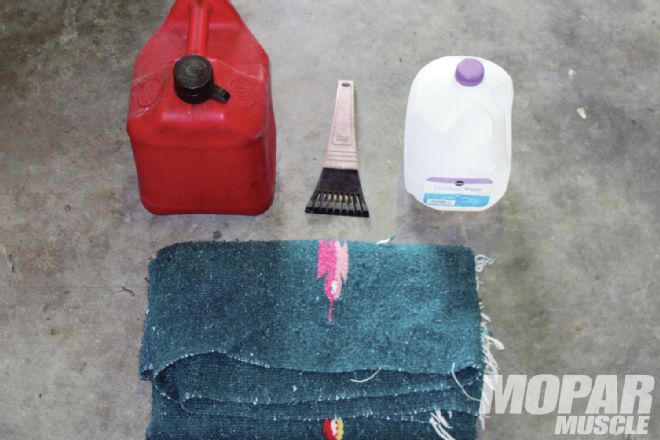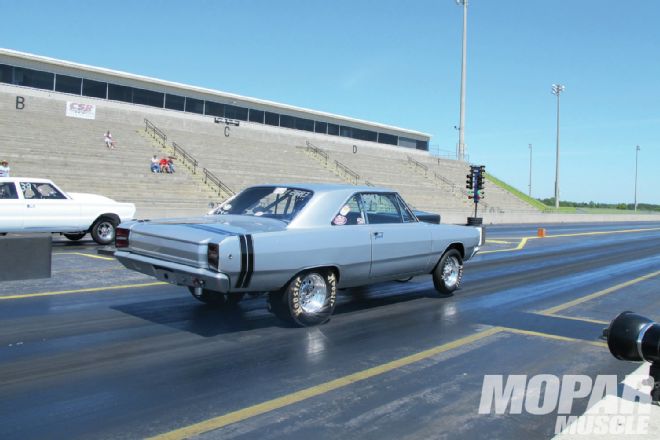
Living in Florida, we’re lucky to be able to enjoy our Mopars year round. In fact, we often get more pleasure from driving our cars during the Winter months since temperatures and humidity are more moderate. If you’re not fortunate enough to live in the South, or if you just enjoy the diversity of the seasonal changes that come from living in the Northern latitudes, then Winter offers some complications when it comes to your classic (or modern) Mopar. Winter, and the associated snow, sleet, salt, and freezing temperatures, pose some serious problems to your car whether you store your vehicle or drive it during these months. In this issue of Mopar Muscle, we’ll show you how to properly prepare your Mopar for the cold months of Winter.
Whether you drive, show, or race your Mopar, the Winter months can be a time for you to give your car a break, and perform routine maintenance to prepare the vehicle for the next season. For racers, Winter is a time to freshen up the engine and transmission, and make upgrades to the car so it’s even quicker in the spring. For show cars, the months when inclement weather keeps you from driving or attending events present an ideal time for a tune-up, detailing, and replacing parts or making upgrades. For vehicles that are driven daily year-round, the Winter presents a different set of problems, both in keeping your car looking good, as well as running its best in the cold weather. And while the editorial staff of Mopar Muscle resides in sunny Florida, we all have roots in the northern states of Indiana, Pennsylvania, and Michigan, so we have some good advice about how to best preserve your car during the Winter months, whether driving or storing the vehicle.
Liquid No-Freeze
We all know that one of the issues related to cold weather, is that the cooling system of the car needs to be filled with the appropriate amount of antifreeze. Without antifreeze, the radiator, hoses, and even the engine block and cylinder heads can be susceptible to damage in cold weather. If the car’s cooling system is filled with water, or an insufficient amount of antifreeze mixed with water, the coolant will freeze solid inside the system. Since frozen water expands, the expansion can rupture hoses or cause radiator leaks. But, if coolant freezes in the block or heads, it can push the core plugs (freeze plugs) out, or worse yet, cause cracks in the water jackets. Cracks in cast-iron engine components can ruin the engine, or be very costly to repair, so we recommend filling the cooling system with high-quality antifreeze as a first step in Winterizing a vehicle.
Antifreeze is not just a Wintertime consideration, as it also provides protection during the summer months. Antifreeze provides corrosion protection, keeping the water jackets from rusting, and also has a higher boiling point than water, so the proper amount of antifreeze should be maintained year-round, not just during the Winter months. To add antifreeze to the cooling system, be sure to drain enough coolant so that the proper ratio of antifreeze and water can be used to fill the system. How much antifreeze? We recommend a minimum ratio of 50 percent anti-freeze to 50 percent water, no matter how warm the climate you live in, but in colder climates a higher ratio of anti-freeze must be added. A special tool for measuring the specific gravity of the coolant in your vehicle is available at most auto parts stores, and will quickly let you know what temperature your cooling system will be protected to. Always remember to run your engine and let the antifreeze completely mix with the coolant before testing, as simply draining the radiator and re-filling it with anti-freeze will only protect the radiator, not the engine, heads, heater core, and other components. If in doubt, 100 percent antifreeze will always protect your engine to the coldest temperatures.
For racers who don’t run antifreeze in their car’s cooling system because it is not allowed by sanctioning bodies (coolant is difficult to clean up if it leaks onto the track), there are a couple of options to ensure your engine doesn’t freeze during the Winter. First, you can drain the water from the cooling system and replace it with antifreeze. Then when racing season begins, drain the antifreeze and replace it with water. Alternatively, the cooling system can be completely drained for the Winter months, but this can be tricky. Any water left in the block can still freeze, so compressed air should be used to blow out the water passages. Additionally, if you forget the system is drained and start the engine with no coolant, damage can occur. For these reasons we recommend replacing the coolant with antifreeze, even in race vehicles.
Cold Storage
If you plan to store your vehicle during the Winter months, there are other precautions you should take in addition to servicing the cooling system with antifreeze. Having you ever thought about placing the car on jack stands to prevent the tires from flat-spotting? Storing a car and not exercising it on a regular basis can be harder on a car than driving it, especially if the car is stored in a cold environment. If you plan to keep your car stored for an extended period of time, there are several items that should be addressed prior to and during storage.
Engine coolant isn’t the only fluid in a car that can freeze, so before storing a car for the Winter it is important to take actions to prevent the battery or fuel system from freezing. A battery is filled with electrolyte, which is a mixture of acid and water, and the water in the battery can be susceptible to freezing in extremely cold environments. The best way to prevent a car’s battery from freezing is to keep the battery fully charged, as a fully charged battery will not freeze. So if your Mopar has an aftermarket radio, or other equipment that can slowly drain the battery, we recommend fully charging and then disconnecting the battery when the car is put into storage. Another good idea is to install a trickle-charger, or battery maintainer, while the car is in storage. Battery manufacturers like Optima offer their own chargers, with a “maintain” setting that is ideal for long-term storage. Keeping the battery charged will not just keep it from freezing, but also extend battery life and ensure the battery is ready to start the engine when the car is ready to be used again in the spring.
The fuel system of the car is also prone to freezing in Winter, especially if fuel with ethanol has been used, or if the fuel system is less than full during storage. Most automotive gasoline is mixed with up to 10-percent Ethanol, and aside from the corrosive properties of Ethanol, it also tends to absorb water and moisture from the atmosphere. To counteract this tendency, we recommend mixing a fuel additive, such as Carb Defender from Driven, to the fuel system. There are other products, such as Sta-bil, and Heet, that can also help prevent fuel system freezing, and one of these products should be considered for long-term storage.
Another way to keep the fuel system from freezing is to stop the possibility of condensation inside the fuel tank by keeping the tank full. An empty fuel tank acts like its own atmosphere, and as temperature fluctuates, water condensation can form inside the tank and contaminate the fuel. By filling the tank with fuel, there is simply nowhere for condensation to form, and the fuel stays clean. Gasoline doesn’t begin to varnish until it has sat stagnant for eight months or so (depending on the fuel), so filling the tank for Winter storage is a good way to protect the fuel system.
Windshield washer fluid can freeze as well, even if it is blue in color. There are different grades of windshield washer fluid available, and they are rated by temperature. Nearly all washer fluid is blue in color, but that doesn’t mean it will not freeze. Be sure to read the label on the windshield washer fluid you put in your washer reservoir, and be sure it will not freeze at the temperatures you expect where you will be storing your car. Water, of course, will freeze and should not be used as washer fluid during Winter months.
 <strong>09</strong> If you drive your Mopar during the winter, changing to engine oil with a lower viscosity rating will protect the engine during cold starts and also make the engine easier to start on cold mornings. Also, be sure the choke system is working and consider increasing jet size in the carburetor to compensate for denser, colder air.
<strong>09</strong> If you drive your Mopar during the winter, changing to engine oil with a lower viscosity rating will protect the engine during cold starts and also make the engine easier to start on cold mornings. Also, be sure the choke system is working and consider increasing jet size in the carburetor to compensate for denser, colder air.
A good quality car cover is another way to protect your car’s finish while it is being stored -- whether inside or outside. Care should be taken however, regarding covering a car that will sit outside in windy conditions. Even if a car cover is soft, wind can cause it to rub the paint, and over time this rubbing can cause paint defects. So if you’re storing your car outside, be sure to use a high-quality, tight fitting car cover. If stored inside, a looser fitting car cover or even sheets or quilts can be used to cover your Mopar. Regardless of the cover used, a good coat of wax prior to storage will also help ensure your car’s paint survives the Winter and looks its best when the car is brought out of storage in spring.
Pests can be a problem when storing your car, especially in areas where the temperature varies between below freezing and above freezing. Insects can infest your car, and rodents and small animals love to find cozy corners where they can nest. There are a couple of easy ways we’ve found to prevent critters and insects from taking refuge in your Mopar. First, make sure your windows and vents are shut, and any holes in your car’s floors or gaps in weather-stripping are plugged up. Next, covering the exhaust pipes will not only keep pests out, but also prevent moisture from entering the exhaust and engine via open exhaust valves. Last, we’ve found moth balls a good way to keep insects and furry creatures away from your car during storage. Moth balls are especially effective against insects, but animals also don’t like the scent and stay away. Just a couple of bowls of moth balls inside and around your car can keep pests out for many months.
You may think that many of these precautions aren’t necessary if your car is stored in a climate controlled environment, and you could be right. But remember, Winter storms can knock down power lines, causing power failures, and eliminating the controlled climate you counted on to preserve your vehicle. So even if you have a heated garage, adhering to the advice offered here will ensure your vehicle stays in great shape, even if the power goes out.
Driving During Winter
Many of us drive our collector vehicles at least on a limited basis during the Winter months, and some of us only have one vehicle so we have to drive it year-round. And if you plan to drive your vehicle during the Winter you should abide by many of the same precautions as you would if storing the vehicle, with some important additional considerations.
During Winter, a car’s engine will run cooler due to the colder ambient air, so there are a couple of changes you might want to make. Using engine oil with a lower viscosity rating will not only offer better flow, and better protection during Winter months, it will also provide easier cold starts. We know that 20W50 engine oil is a popular choice for summer months, but during the Winter you should consider switching to 10W30, or even lighter viscosity engine oil.
 <strong>12 </strong>If you drive during winter, you need to have a minimum amount of emergency equipment with you. We recommend a blanket, drinking water, ice scraper, and extra fuel at the very least. A snow shovel can also help you get your car unstuck if you find yourself in a snow drift.
<strong>12 </strong>If you drive during winter, you need to have a minimum amount of emergency equipment with you. We recommend a blanket, drinking water, ice scraper, and extra fuel at the very least. A snow shovel can also help you get your car unstuck if you find yourself in a snow drift.
During summer months, keeping the engine cool can be a problem, so we often choose to install a 160 degree thermostat. During the Winter, a car’s cooling system may cool the engine too well, not allowing the engine to achieve proper operating temperature. An engine that won’t warm up not only risks engine damage, but also makes for an uncomfortable ride as the heater won’t warm the cabin of the car. For Winter driving, try installing a 195 degree thermostat, and even covering a portion of the radiator with cardboard to block cold air from passing through it.
Driving during the Winter often subjects a vehicle to ice, snow, sleet, and freezing rain, as well as salt and sand that road crews use to keep the roads passable. All of these elements can take a toll on a car, especially the wheels and bottom side of the car, but there are precautions that can minimize or prevent damage. If you have a nice set of wheels on your Mopar, you should consider replacing them with a “beater” set of steel wheels for the Winter months. Also, be sure to rinse your car with plenty of fresh water on days when it is warm enough, rinsing away the salt and grime caused by Winter driving. Many self-serve car washes in the northern states offer heated water, and the two or three bucks is money well spent to keep your car clean during the Winter.
13 If you’re a racer, chances are you can’t run antifreeze in your Mopar due to track rules. In this situation, we recommend completely draining the water from your car’s cooling system and installing antifreeze for the off-season. "> <strong>13 </strong>If you’re a racer, chances are you can’t run antifreeze in your Mopar due to track rules. In this situation, we recommend completely draining the water from your car’s cooling system and installing antifreeze for the off-season.
<strong>13 </strong>If you’re a racer, chances are you can’t run antifreeze in your Mopar due to track rules. In this situation, we recommend completely draining the water from your car’s cooling system and installing antifreeze for the off-season.
Lastly, if you plan to drive your Mopar during the Winter you should seriously consider carrying a blanket, some drinking water, extra gasoline, and an ice scraper as minimum safety equipment. No matter how well your Mopar runs, you can never tell when you’ll have a mechanical issue, or simply get stuck in the snow or ice. Having extra gas can keep the car running (and heat working), and a blanket and drinking water will increase your odds of surviving an extended stay in the snow. As for the ice scraper, that one is self-explanatory. Of course we’ve been known to use a cassette case to scrape ice, which shows our age. A CD case might work just as well, but we can’t guarantee how well an iPod works to scrape ice from your windshield. From all of us at Mopar Muscle, happy motoring and we hope to see you and your Mopar next spring!